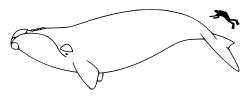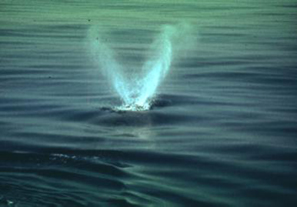Right whale facts for kids
Quick facts for kids Right whale |
|
|---|---|
 |
|
| Right Whale | |
 |
|
| Size comparison against an average human | |
| Scientific classification | |
| Kingdom: | |
| Phylum: | |
| Class: | |
| Order: | |
| Suborder: | |
| Family: | |
| Genus: |
Eubalaena
Gray, 1864
|
| Species | |
 |
|
| Persebaran spesies Eubalaena. | |
The right whales (Eubalaena spp.) are large whales. They are a type of baleen whale, which means they have special plates in their mouths instead of teeth. These plates help them filter tiny food from the water.
Right whales have a unique look. Their lower jaw is shaped like a bow. Their head can be up to one-quarter of their whole body length. They also have rough patches of skin called callosities on their heads. These are found behind their blowhole, on their chin, above their eyes, and on their upper and lower lips. Right whales are very heavy, weighing about 70 tons.
Contents
What Makes Right Whales Special?
Right whales are easy to spot because of their unique features. They have rough patches of skin, called callosities, on their heads. Unlike many other whales, they do not have a dorsal fin (a fin on their back). Sometimes, they have white patches on their bellies. Their upper jaw is long and curved, starting above their eye.
These whales are similar to bowhead whales but are a bit smaller. Right whales have a lot of blubber, which is a thick layer of fat. They also have two blowholes. Their eyes are very small, but their lips are large. Whalers gave them the name "right whales" because they were considered the "right" whales to hunt. This was because they had a lot of blubber, were slow swimmers, and floated after being killed.
Why Were They Hunted?
Hunters wanted right whales mainly for their blubber. This blubber could be boiled down to make oil. This oil was used for lamps and other purposes.
The name "right whale" came from hunters. They thought these whales were the "right" ones to catch. This was because right whales were full of blubber. They were also easy to hunt since they swam slowly. Plus, they floated on the water after they were killed, making them easy to collect. Because of all this hunting, right whales are now among the most endangered of the large whales.
What Do Right Whales Eat?
Right whales mostly eat tiny ocean creatures called zooplankton. Their favorite foods include small crustaceans called copepods, as well as krill and pteropods. They are filter feeders, just like other baleen whales.
To eat, a right whale swims with its mouth open. It fills its mouth with water and tiny prey. Then, the whale pushes the water out, but its baleen plates keep the food inside. The food must be plentiful, big enough for the baleen to catch, and slow enough not to escape. Right whales can feed at the surface, underwater, or even near the ocean bottom. Sometimes, mud is seen on their bodies, showing they have been feeding deep down.
Who Are Their Predators?
Right whales have two main predators: humans and orcas. When danger is near, a group of right whales might form a circle. They will then thrash their tails outwards to protect themselves. They might also try to swim into shallow water. However, this defense does not always work.
Their large size is their best protection. They also have strong tails and massive heads with callosities. Young calves are the most at risk from orca and shark attacks.
Where Do Right Whales Live?
There are three types of Eubalaena species, and each lives in a different part of the world.
- The North Atlantic right whale lives in the western Atlantic Ocean.
- The North Pacific right whale lives in a band from Japan to Alaska.
- The Southern right whale lives in all areas of the Southern Ocean.
These whales prefer moderate temperatures, usually between 20 and 60 degrees latitude. Warm waters near the equator act like a barrier. This barrier stops the northern and southern groups from mixing. Even though some southern species travel across open ocean to find food, they usually stay close to land. They prefer peninsulas, bays, and continental shelves. These areas offer more shelter and plenty of their favorite foods.
It is hard to know exactly how many whales there are because the oceans are so vast. Here are some approximate numbers:
- About 400 North Atlantic right whales (Eubalaena glacialis) live in the North Atlantic.
- Around 23 North Pacific right whales have been found in the eastern North Pacific (Eubalaena japonica).
- About 15,000 southern right whales (Eubalaena australis) live in the southern part of the Southern Hemisphere.
North Atlantic Right Whale Habitat
Almost all of the 400 North Atlantic right whales live in the western North Atlantic Ocean. In spring, summer, and autumn, they feed off the coasts of Canada and the northeast U.S. This area stretches from New York to Newfoundland. Popular feeding spots include the Bay of Fundy and Cape Cod Bay. In winter, they travel south to Georgia and Florida to have their calves.
Some sightings have happened further east in recent decades, including near Iceland in 2003. These might be the last few whales from a group that used to live in the eastern Atlantic. However, old whaling records suggest these are more likely whales that have strayed from their usual path. A few sightings are regular near Norway, Ireland, Spain, Portugal, the Canary Islands, and even Italy and Sicily. The whales seen near Norway probably come from the western group.
North Pacific Right Whale Habitat
The North Pacific right whale seems to have two groups. The group in the eastern North Pacific and Bering Sea is very small, with only about 30 whales. A larger group of 100–200 whales appears to be surviving in the Sea of Okhotsk. However, not much is known about this group.
Because of their low numbers, the two northern right whale species are among the most endangered animals in the world. Based on current trends, both species might become extinct within 200 years. Historically, the Pacific species was found in summer from the Sea of Okhotsk in the west to the Gulf of Alaska in the east, generally north of 50°N. Today, sightings are very rare. They usually happen at the mouth of the Sea of Okhotsk and in the eastern Bering Sea. While this species likely migrates like the others, their exact travel patterns are unknown.
Southern Right Whale Habitat
The last big study of southern right whale populations was in 1998. Researchers used data from adult female whales in Argentina, South Africa, and Australia. They then estimated numbers for other areas and included males and calves. This led to an estimated population of 7,500 animals in 1997.
More recent data from 2007 shows that these survey areas have seen strong recovery. The population is now almost double what it was a decade earlier. However, other breeding groups are still very small. There is not enough data to know if they are also recovering.
The southern right whale spends its summer months feeding in the far Southern Ocean, probably near Antarctica. In winter, it travels north to breed. These whales can be seen around the coasts of Argentina, Australia, Brazil, Chile, Mozambique, New Zealand, South Africa, and Uruguay. Since hunting of the southern right whale stopped, their numbers are estimated to have grown by 7% each year. The groups in South America, South Africa, and Australasia do not mix much. This is because mothers are very loyal to their feeding and calving grounds. They pass these instincts on to their calves.
How Do Right Whales Communicate?
The sounds made by right whales are not as complex as those made by some other whale species. They make groans, pops, and belches. These sounds are usually around 500 Hz. The reason for these sounds is not fully known. They might be a way for whales within the same group to talk to each other.
Northern right whales have reacted to sounds similar to police sirens. These sounds are much higher in frequency than their own calls. When they hear these sounds, they quickly move to the surface. This research is interesting because northern right whales usually ignore most sounds, even those from approaching boats. Scientists think this information could help reduce collisions between ships and whales. It might also make it easier for researchers to study whales at the surface.
Images for kids
-
North Pacific right whale in Half Moon Bay, California, March 20, 1982, photo by Jim Scarff
-
Southern right whale in the breeding grounds at Peninsula Valdés in Patagonia
-
A southern right whale approaches close to whale watchers near Península Valdés in Patagonia
See also
 In Spanish: Eubalaena para niños
In Spanish: Eubalaena para niños











